Pissed Off Turkmen Want Their Town Back
Iraq’s Shia Turkmen militia counterattack in Bashir
by MATT CETTI-ROBERTS
An Iraqi Turkmen militiaman stands on a black Ford F250 Super Duty and stares off into the distance. Above there’s the hazy midday sun. In front of him, there’s the front line in the war with Islamic State.
Three Islamic State fighters approach the front line — a sandy berm stretching into the distance on either side of the miltiaman’s position. IS is notorious for using teams of suicide bombers, so the Turkmen fighter cannotallow them to get close.
Reaching toward the truck’s mounted KPV 14.5-millimeter heavy machine gun, he racks back the cocking handle, swivels the weapon toward no-man’s land and fires three short bursts.
The militants scatter back the way they came.
It’s early April and beyond the earthen berm, less than a mile away, is the Islamic State-held town of Bashir. The town sits around 10 miles southwest of Kirkuk.
The fighters occupying the front line here are mainly Shia Turkmen from the local area working as part of Iraq’s predominantly Popular Mobilization Forces — also known as the Hashd Shaabi.
In a few days, they will carry out another attack to retake the town.
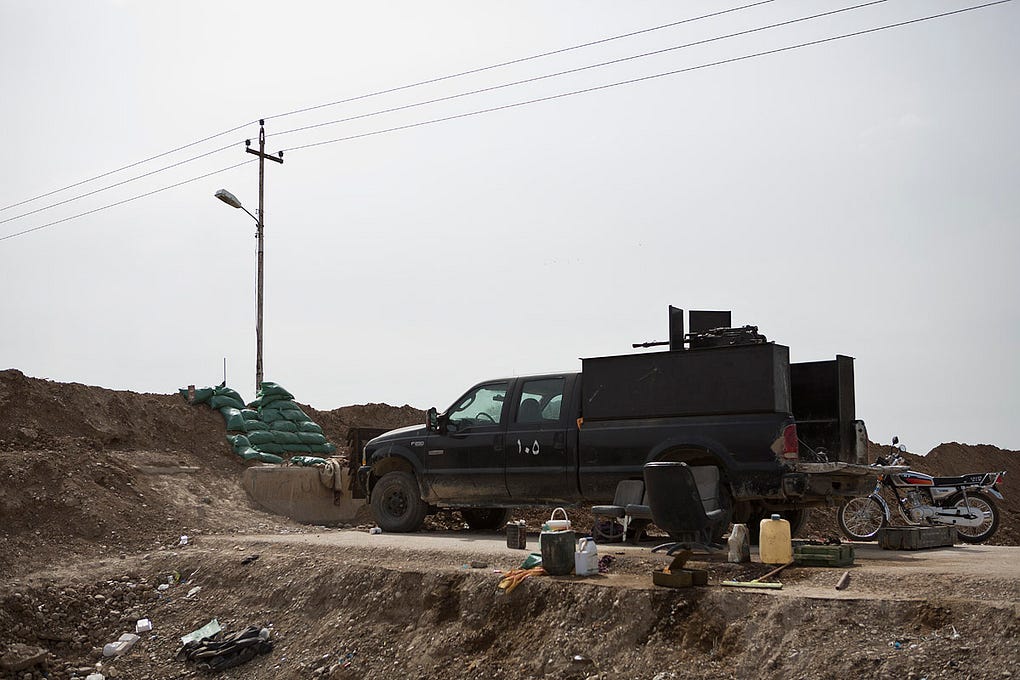
At top — a Shia Turkmen fighter of the Martyr Sadr Force stands on the roof of his unit’s base near Kirkuk. Above — a Badr Organisation position at the front line outside Bashir. Matt Cetti-Roberts photos
The Turkmen are one of Iraq’s largest minority groups, descended from various waves of migration dating back to the 7th century. Although they inhabit areas across central Iraq, many lived in villages to the south of Kirkuk before Islamic State came.
Bashir is widely considered the heart of the Iraqi Turkmen community. They once constituted 40 percent of its population.
But in 2014, Islamic State swept through Iraq. In June, Bashir fell. Iraqi army troops based at the nearby K-1 Airbase fled, and left their weapons and vehicles behind. The Kurdish Peshmerga rushed in to fill the security vacuum in and around oil-rich Kirkuk.
One of the Iraqi army troops who fled is now back. Maj. Abdul Hussein Abass sits behind a desk inside a base for the Hash Shaabi’s Martyr Sadr Force.
Shia religious flags fly from the roofs of the base’s buildings. “When ISIS took Bashir, 23 people were killed, including women and children,” Abdul says — while surrounded by Turkmen Shia fighters.
“I am from Bashir originally,” Abdul, who is Turkman Shia himself, says. “It’s my neighborhood, so I joined the fight. I am a military man.”
“We are here to protect our land, especially Turkman Shia, [but] we don’t have racism,” Abdul says. “We are all here. There aren’t many of us so we have to work together. Ten Sunni guys joined, we never say no.”
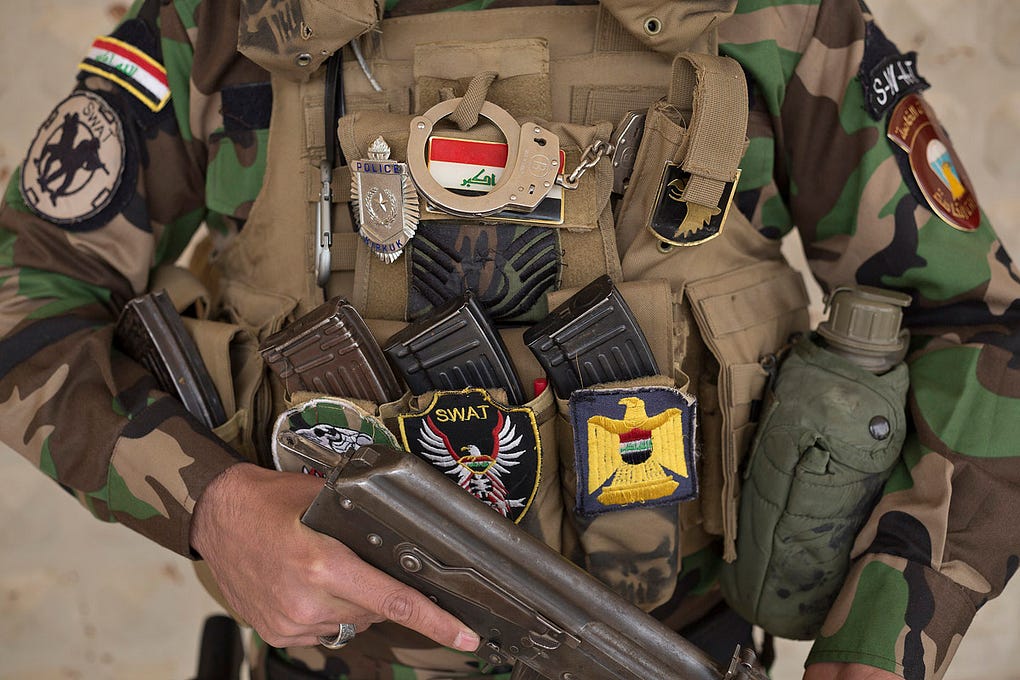
The Turkmen are one of Iraq’s largest minority groups, descended from various waves of migration dating back to the 7th century. Although they inhabit areas across central Iraq, many lived in villages to the south of Kirkuk before Islamic State came.
Bashir is widely considered the heart of the Iraqi Turkmen community. They once constituted 40 percent of its population.
But in 2014, Islamic State swept through Iraq. In June, Bashir fell. Iraqi army troops based at the nearby K-1 Airbase fled, and left their weapons and vehicles behind. The Kurdish Peshmerga rushed in to fill the security vacuum in and around oil-rich Kirkuk.
One of the Iraqi army troops who fled is now back. Maj. Abdul Hussein Abass sits behind a desk inside a base for the Hash Shaabi’s Martyr Sadr Force.
Shia religious flags fly from the roofs of the base’s buildings. “When ISIS took Bashir, 23 people were killed, including women and children,” Abdul says — while surrounded by Turkmen Shia fighters.
“I am from Bashir originally,” Abdul, who is Turkman Shia himself, says. “It’s my neighborhood, so I joined the fight. I am a military man.”
“We are here to protect our land, especially Turkman Shia, [but] we don’t have racism,” Abdul says. “We are all here. There aren’t many of us so we have to work together. Ten Sunni guys joined, we never say no.”

The badge-adorned load carrying vest of a Turkmen Martyr Sadr Force fighter. Matt Cetti-Roberts photo
Abdul says that improvised explosive devices — or IEDs — are a major obstacle to retaking the town.
“When we say we will take Bashir, the fighters move and don’t think there are bombs,” Abdul says. “They are all thinking of the fatwa, it is inside their brain pushing them to this kind of work.”
After his unit evaporated during the Islamic State advance last year, he moved to the Kurdish capital of Erbil and registered to join Unit 16 — the Turkmen Hashd Shaabi formation that covers the area from Tuz Khumartu to Kirkuk.
From there, he helped liberate the besieged Turkmen town of Amerli in September 2014.
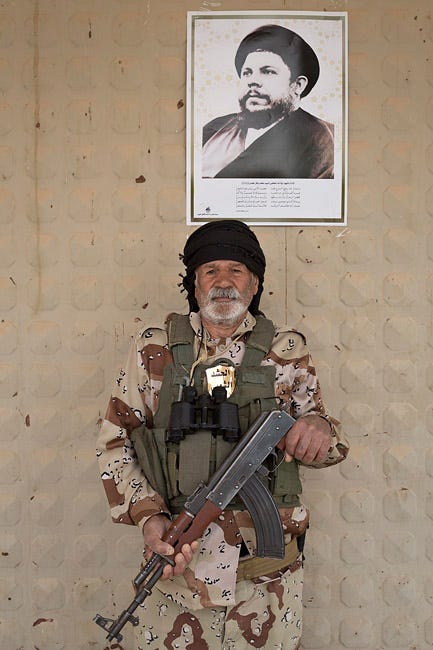
Abdul says that improvised explosive devices — or IEDs — are a major obstacle to retaking the town.
“When we say we will take Bashir, the fighters move and don’t think there are bombs,” Abdul says. “They are all thinking of the fatwa, it is inside their brain pushing them to this kind of work.”
After his unit evaporated during the Islamic State advance last year, he moved to the Kurdish capital of Erbil and registered to join Unit 16 — the Turkmen Hashd Shaabi formation that covers the area from Tuz Khumartu to Kirkuk.
From there, he helped liberate the besieged Turkmen town of Amerli in September 2014.

A Shia Turkmen fighter of the Martyr Sadr Force stands beneath a portrait of Muhammad Baqir Al Sadr, a Shia cleric executed in 1980 by the Ba’athists, at the unit’s base near Kirkuk. Matt Cetti-Roberts photo
On June 29, 2014, Abdul took part in the first attack on Bashir, where 26 Turkmen died. He tells us that the fighters were not organized properly — unlike now under the Hashd Shaabi.
But this isn’t the first time Bashir’s residents were forced from their homes.
In 1986, Saddam Hussein’s Arabization policy displaced the town’s Turkmen. The plan was to bring in loyal Sunni tribes to areas where minority groups who opposed the regime flourished.
“I remember I was in the sixth grade, I didn’t pass that year of school,” Abdul recalls. “They [the Iraqi army] said the sewage pipes didn’t work so we couldn’t stay in Bashir — then they gave it to to the Sunni Arabs.”
When American forces invaded in 2003, the Turkmen returned from exile to reclaim their homes. Fighting between returning Turkmen and Sunni Arabs eventually saw Saddam’s emigres forcibly ejected.
Many Sunnis remained in the outlying villages and some joined Islamic State. “Whoever was working with ISIS of course can’t come back home [and] has to go to prison, we have names and intelligence of these people,” Abdul adds.
“We are from this land and trying to protect this land. We are trying to defend Bashir, because it is our land, our property,” he says, explaining why only the Shia Turkmen are trying to liberate the town.
He also doesn’t see Unit 16 having a role in any future liberation of Mosul — a majority Sunni city. He believes former residents of the city should be involved in the operation instead.

On June 29, 2014, Abdul took part in the first attack on Bashir, where 26 Turkmen died. He tells us that the fighters were not organized properly — unlike now under the Hashd Shaabi.
But this isn’t the first time Bashir’s residents were forced from their homes.
In 1986, Saddam Hussein’s Arabization policy displaced the town’s Turkmen. The plan was to bring in loyal Sunni tribes to areas where minority groups who opposed the regime flourished.
“I remember I was in the sixth grade, I didn’t pass that year of school,” Abdul recalls. “They [the Iraqi army] said the sewage pipes didn’t work so we couldn’t stay in Bashir — then they gave it to to the Sunni Arabs.”
When American forces invaded in 2003, the Turkmen returned from exile to reclaim their homes. Fighting between returning Turkmen and Sunni Arabs eventually saw Saddam’s emigres forcibly ejected.
Many Sunnis remained in the outlying villages and some joined Islamic State. “Whoever was working with ISIS of course can’t come back home [and] has to go to prison, we have names and intelligence of these people,” Abdul adds.
“We are from this land and trying to protect this land. We are trying to defend Bashir, because it is our land, our property,” he says, explaining why only the Shia Turkmen are trying to liberate the town.
He also doesn’t see Unit 16 having a role in any future liberation of Mosul — a majority Sunni city. He believes former residents of the city should be involved in the operation instead.

A militia flag. Matt Cetti-Roberts
Reprisals
Colorful flags of Iraq’s powerful Shia forces flutter along the front line. On the walls of the Martyr Sadr Force’s base are pictures of Muhammad Baqir Al Sadr, a Shia cleric executed in 1980 by Saddam’s Ba’athist regime.
But the Shia militias’ sectarian nature has provoked fears of retribution attacks against Sunnis. Iraq’s mainly Shia Popular Mobilization Forces were brought together by a fatwa — a religious call to arms — by Grand Ayatollah Ali Al Sistani.
In 2014, Iraq’s then-Prime Minister Nouri Al Maliki authorized the miitias’ deployment and gave them official backing. The militias have since been at the forefront of victories over Islamic State, beating them back in Diyala province and parts of Salahaddin.
But human rights groups have accused Shia fighters of carrying out sectarian attacks against Sunnis — looting homes, setting property on fire and carrying out executions.
There’s even been recurring friction between the Hashd Shaabi and the Peshmerga, such as Tuz Kharmato. Recent reports emerged that the Peshmerga told 80 members of the Saraya Tali’a Al Khurasani militia to leave Jalawla. In January 2015, the Shia told the Peshmerga to leave.
Abdul denies any problems with his unit. “The media says that Hashd Shaabi murders and loots,” he says. “We took Jedadyah [a village close to Bashir] back and didn’t take anything, but ISIS took everything from there.”
Although his group didn’t loot the town, he says, another unit he won’t name tried, and he sent them away. “I won’t let you take anything from that village, go to get permission from the governor,” he claims he told them.
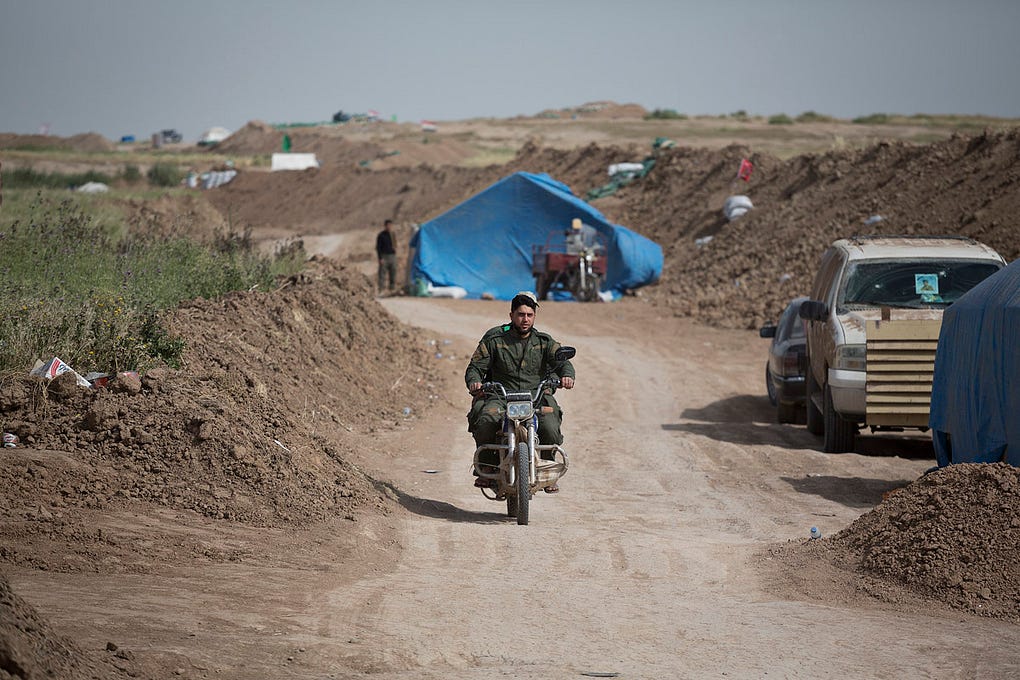
Reprisals
Colorful flags of Iraq’s powerful Shia forces flutter along the front line. On the walls of the Martyr Sadr Force’s base are pictures of Muhammad Baqir Al Sadr, a Shia cleric executed in 1980 by Saddam’s Ba’athist regime.
But the Shia militias’ sectarian nature has provoked fears of retribution attacks against Sunnis. Iraq’s mainly Shia Popular Mobilization Forces were brought together by a fatwa — a religious call to arms — by Grand Ayatollah Ali Al Sistani.
In 2014, Iraq’s then-Prime Minister Nouri Al Maliki authorized the miitias’ deployment and gave them official backing. The militias have since been at the forefront of victories over Islamic State, beating them back in Diyala province and parts of Salahaddin.
But human rights groups have accused Shia fighters of carrying out sectarian attacks against Sunnis — looting homes, setting property on fire and carrying out executions.
There’s even been recurring friction between the Hashd Shaabi and the Peshmerga, such as Tuz Kharmato. Recent reports emerged that the Peshmerga told 80 members of the Saraya Tali’a Al Khurasani militia to leave Jalawla. In January 2015, the Shia told the Peshmerga to leave.
Abdul denies any problems with his unit. “The media says that Hashd Shaabi murders and loots,” he says. “We took Jedadyah [a village close to Bashir] back and didn’t take anything, but ISIS took everything from there.”
Although his group didn’t loot the town, he says, another unit he won’t name tried, and he sent them away. “I won’t let you take anything from that village, go to get permission from the governor,” he claims he told them.

Two Turkmen fighters of the Badr Organisation ride a motorbike along the front line near Bashir. Matt Cetti-Roberts photo
Shaker Hassan Ali, a Turkman spokesperson for the Hashd Shaabi’s Badr Organization based in their Kirkuk offices has a … different take. He says that Islamic State dressed up as Popular Mobilization Troops and carried out looting as a form of disinformation.
“A man with Hashd Shaabi hasn’t seen his family, he is not going back to take things, he is going to fight and be a martyr — he’s not there to steal,” Ali says.
The Iraqi Shia Badr Organization is one of Iraq’s most powerful paramilitary groups. Originally set up in 1982 and — at that time — led by Iranian officers, they were accused of sectarian killings during the 2006–07 Iraqi civil war.
They now operate under the umbrella of the Hashd Shaabi. Shaker says they have around 5,000 fighters in the Kirkuk area and — he claims — even have Christians and Sunni among them.
“If there had been no fatwa in Iraq it would have been a bad situation,” Shakar says as he sits in a large hall in the Badr’s offices. Today, the organization is having a ceremony to remember one of their colonels who died fighting in Tikrit.
In the dim hall lit by fluorescent tubes, two portraits of a man wearing a uniform photoshopped onto an Iraqi flag sit on a table. His name was Qassim Avaf, a fighter who died in the Turkmen’s first attack on Bashir in June 2014.
The militia found his body in no-man’s land.
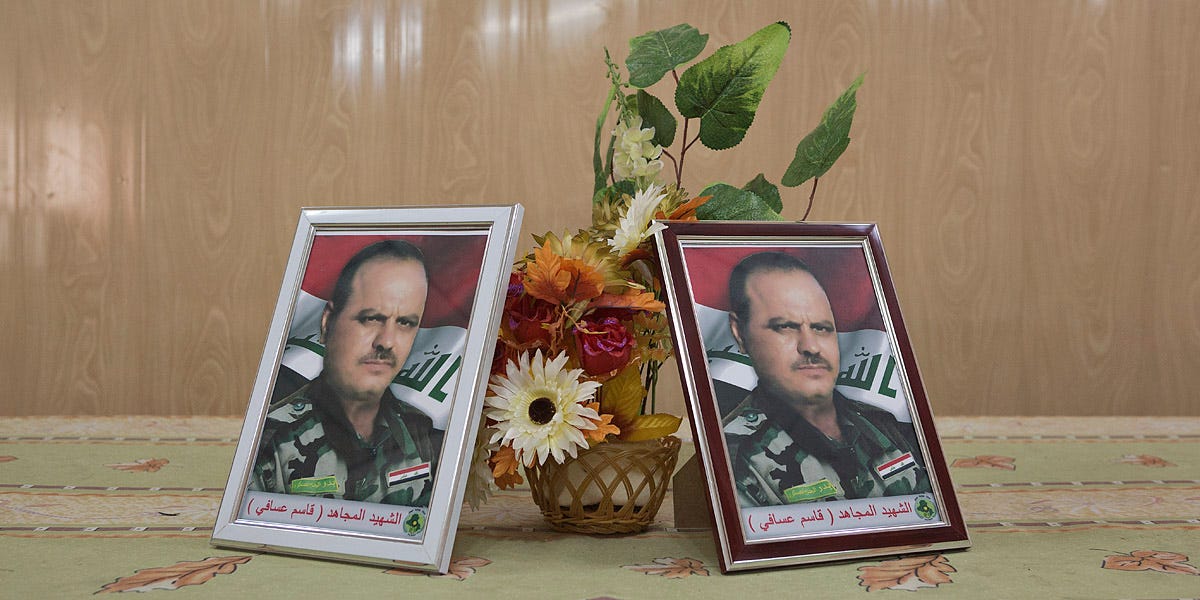
Shaker Hassan Ali, a Turkman spokesperson for the Hashd Shaabi’s Badr Organization based in their Kirkuk offices has a … different take. He says that Islamic State dressed up as Popular Mobilization Troops and carried out looting as a form of disinformation.
“A man with Hashd Shaabi hasn’t seen his family, he is not going back to take things, he is going to fight and be a martyr — he’s not there to steal,” Ali says.
The Iraqi Shia Badr Organization is one of Iraq’s most powerful paramilitary groups. Originally set up in 1982 and — at that time — led by Iranian officers, they were accused of sectarian killings during the 2006–07 Iraqi civil war.
They now operate under the umbrella of the Hashd Shaabi. Shaker says they have around 5,000 fighters in the Kirkuk area and — he claims — even have Christians and Sunni among them.
“If there had been no fatwa in Iraq it would have been a bad situation,” Shakar says as he sits in a large hall in the Badr’s offices. Today, the organization is having a ceremony to remember one of their colonels who died fighting in Tikrit.
In the dim hall lit by fluorescent tubes, two portraits of a man wearing a uniform photoshopped onto an Iraqi flag sit on a table. His name was Qassim Avaf, a fighter who died in the Turkmen’s first attack on Bashir in June 2014.
The militia found his body in no-man’s land.

Two portraits of Qassim Avaf, a fighter who was killed in the first attack on Bashir in June 2014, are seen on a table in the Kirkuk offices of the Badr Organisation. Matt Cetti-Roberts photo
Another attack
Back at the front line, a group of fighters stand together. Another fighter named Abbas, an officer in charge of around 100 Turkmen, stands with a shotgun over his shoulder.
“Three were injured by mortars,” he says, referring to an Islamic State barrage earlier that day. “Since the first attack on Bashir, 64 fighters have been killed and 103 injured.”
Abbas points to his faith as one reason why he joined the Badr Organisation. But he says he wants to take back the town because it belongs to the Turkmen. “We will fight side-by-side to retake the town ourselves, but we need any help we can get, it’s just us on this front line.”
There haven’t been coalition air strikes on this part of the front line, and in Abbas’ opinion, the U.S.-led coalition only supports the Kurdish Peshmerga. The Badr Organization is one of several groups that the coalition does not support with air strikes because of their sectarian agenda, according to a senior coalition forces officer.
So why hasn’t the Hashd Shaabi taken back the town? Abbas replies frankly that there are too many IEDs.
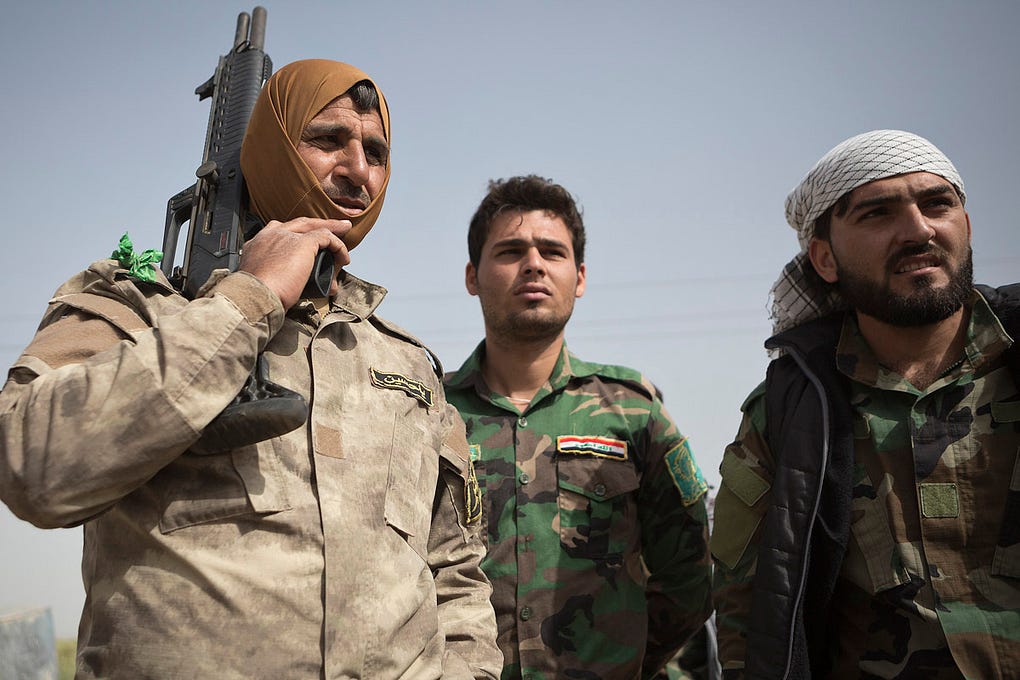
Another attack
Back at the front line, a group of fighters stand together. Another fighter named Abbas, an officer in charge of around 100 Turkmen, stands with a shotgun over his shoulder.
“Three were injured by mortars,” he says, referring to an Islamic State barrage earlier that day. “Since the first attack on Bashir, 64 fighters have been killed and 103 injured.”
Abbas points to his faith as one reason why he joined the Badr Organisation. But he says he wants to take back the town because it belongs to the Turkmen. “We will fight side-by-side to retake the town ourselves, but we need any help we can get, it’s just us on this front line.”
There haven’t been coalition air strikes on this part of the front line, and in Abbas’ opinion, the U.S.-led coalition only supports the Kurdish Peshmerga. The Badr Organization is one of several groups that the coalition does not support with air strikes because of their sectarian agenda, according to a senior coalition forces officer.
So why hasn’t the Hashd Shaabi taken back the town? Abbas replies frankly that there are too many IEDs.

Shia Turkmen fighters, Abbas at left and Abu Mikhail at right, on the front line close to Bashir. Matt Cetti-Roberts photo
Another fighter, 24-year-old Abu Mikhail, left Bashir nine months ago when the town fell to Islamic State. A former carpenter, he joined the Badr Organization the same month.
“The call of fatwa made us join,” he says. “I fight first for faith, then for my country, and also for my brother who died fighting here to get Bashir back.” A few days after our interview, Abu Mikhail was killed when Islamic State detonated a large car bomb during the Turkmen’s attack on Bashir.
Nearly mile behind the Hashd Shaabi is another berm manned by Kurdish troops armed with ancient Soviet tanks and MTLB armored personnel carriers armed with 14.5-millimeter ZPU anti-aircraft guns.
Capt. Hider Sulaiman is a Peshmerga platoon commander. He stands near a T-62 tank.
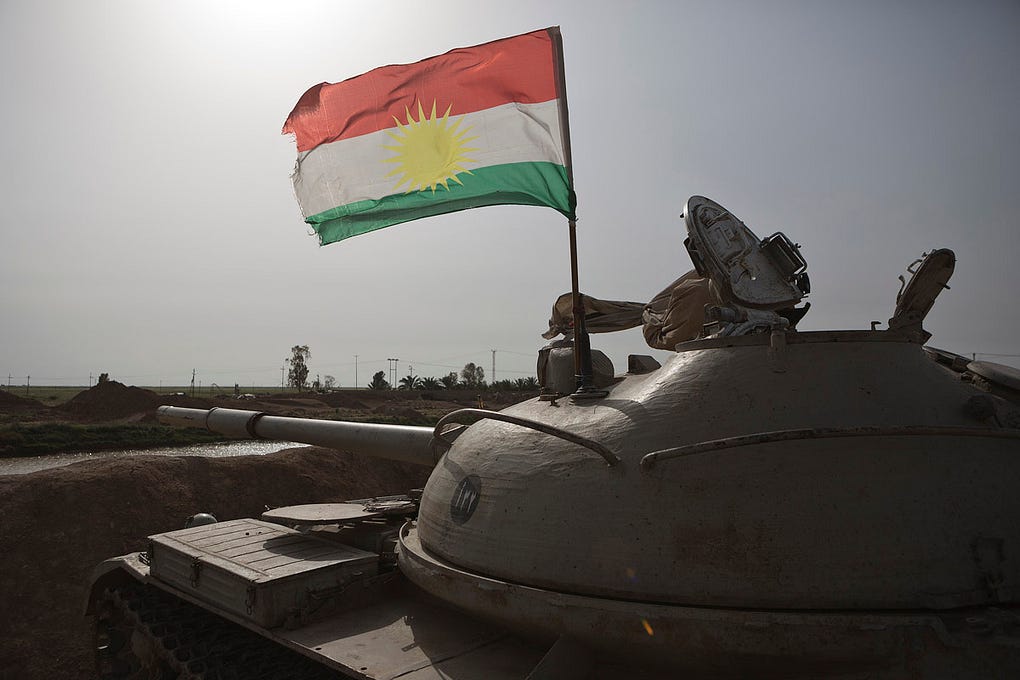
Another fighter, 24-year-old Abu Mikhail, left Bashir nine months ago when the town fell to Islamic State. A former carpenter, he joined the Badr Organization the same month.
“The call of fatwa made us join,” he says. “I fight first for faith, then for my country, and also for my brother who died fighting here to get Bashir back.” A few days after our interview, Abu Mikhail was killed when Islamic State detonated a large car bomb during the Turkmen’s attack on Bashir.
Nearly mile behind the Hashd Shaabi is another berm manned by Kurdish troops armed with ancient Soviet tanks and MTLB armored personnel carriers armed with 14.5-millimeter ZPU anti-aircraft guns.
Capt. Hider Sulaiman is a Peshmerga platoon commander. He stands near a T-62 tank.

The flag of Kurdistan flies from the top of a Kurdish Peshmerga T-62 tank based at a support weapons line around a kilometer behind the Bashir front line. Matt Cetti-Roberts photo
“We work together on this front line,” Hider says.
He adds that both his unit — affiliated with the Kurdistan Democratic Party — and the Badr Organization communicate and work well together.
The presence of the KDP troops working with the Hashd Shaabi may be related to problems between the Popular Mobilization Forces and Peshmerga forces loyal to the Patriotic Union of Kurdistan — the political party that most of the units in this area belong to.
The Peshmerga are not here to take the village, but to support the Shia Turkmen fighters with heavier weaponry such as artillery. The village is Turkmen, so the job of taking it falls to the Hashd Shaabi.
Hider suggests that there may be as few as 50–60 Islamic State left in the town, and half of them could be snipers.
The militants in the town also use mortars to harass the Hashd Shaabi. “This morning they fired mortars. There is no pattern to their firing,” Hider explains. “Sometimes they shell at 2:00 a.m., sometimes 3:00 a.m., sometimes in the evening.”

“We work together on this front line,” Hider says.
He adds that both his unit — affiliated with the Kurdistan Democratic Party — and the Badr Organization communicate and work well together.
The presence of the KDP troops working with the Hashd Shaabi may be related to problems between the Popular Mobilization Forces and Peshmerga forces loyal to the Patriotic Union of Kurdistan — the political party that most of the units in this area belong to.
The Peshmerga are not here to take the village, but to support the Shia Turkmen fighters with heavier weaponry such as artillery. The village is Turkmen, so the job of taking it falls to the Hashd Shaabi.
Hider suggests that there may be as few as 50–60 Islamic State left in the town, and half of them could be snipers.
The militants in the town also use mortars to harass the Hashd Shaabi. “This morning they fired mortars. There is no pattern to their firing,” Hider explains. “Sometimes they shell at 2:00 a.m., sometimes 3:00 a.m., sometimes in the evening.”

Flags bearing names of those killed during the June 2014 attack on Bashir are seen on a wall in the nearby town of Taza. Matt Cetti-Roberts photo
The next attack would take place two days later. The fourth such assault on the town saw 400 Turkmen from all over Brigade 16 — bolstered by other Popular Mobilization forces from the rest of Iraq — attempt to reclaim the Turkmen town.
They failed.
IEDs caused the attack to stall and many — if not all — of the Islamic State insurgents were wearing suicide vests. The militants also drove a large car bomb at the attackers, causing multiple casualties.
The front line is now closer to Bashir, 30 meters in some places, but the town still remains in Islamic State hands.
https://medium.com/war-is-boring/pissed-off-turkmen-want-their-town-back-89d59db228c8
Note: The article by Dr. Hassan Aydinli, Iraqi Turkmen Front EU Representative, about BASHEER has been posted on the European Parliament's website:http://www.europarl.europa.eu/.../tragedyoftheturkmenpeop...
The next attack would take place two days later. The fourth such assault on the town saw 400 Turkmen from all over Brigade 16 — bolstered by other Popular Mobilization forces from the rest of Iraq — attempt to reclaim the Turkmen town.
They failed.
IEDs caused the attack to stall and many — if not all — of the Islamic State insurgents were wearing suicide vests. The militants also drove a large car bomb at the attackers, causing multiple casualties.
The front line is now closer to Bashir, 30 meters in some places, but the town still remains in Islamic State hands.
https://medium.com/war-is-boring/pissed-off-turkmen-want-their-town-back-89d59db228c8
Note: The article by Dr. Hassan Aydinli, Iraqi Turkmen Front EU Representative, about BASHEER has been posted on the European Parliament's website:http://www.europarl.europa.eu/.../tragedyoftheturkmenpeop...

Aucun commentaire:
Enregistrer un commentaire